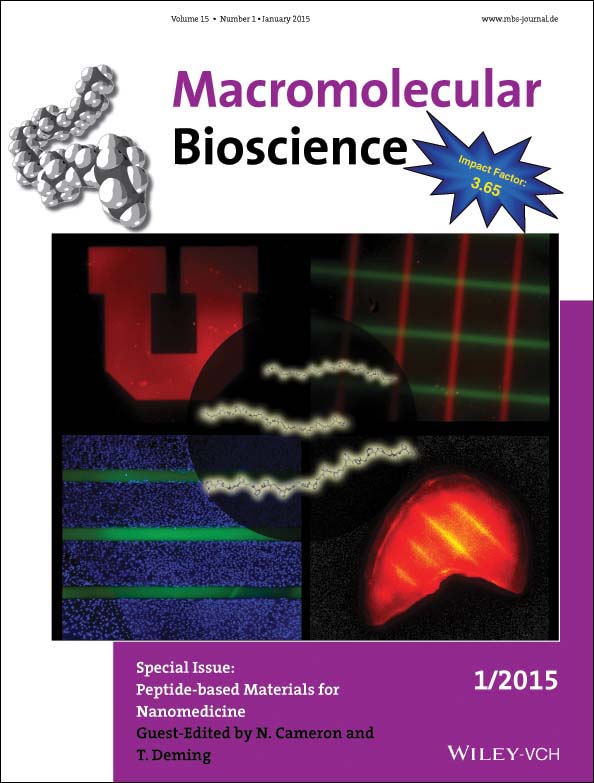Peptide-based Materials for Nanomedicine
There has been an abundance of research in recent years on the development of polymers for medical uses. These materials, formulated in a variety of different forms, such as fibers, micelles, vesicles, hydrogels, emulsion droplets, and thin films, are being developed to incorporate useful functionality for interacting with biological systems. While much has been accomplished with traditional synthetic polymers, improved biomimetic materials are desirable, that can be highly functional as well as degradable, and where individual components are capable of performing multiple functions as often seen in biological materials. Incorporation of such complex functionality can be challenging since many synthetic polymer based systems have limited capability for modification, and when functionalized, finely balanced properties may be significantly altered or impaired. For these reasons, there is a need for biomimetic polymers that can be prepared using versatile methods allowing for fine tuning of chemical composition and structure, and using building blocks that are biocompatible, biodegradable, and easily functionalized.
Incorporation of peptide and polypeptide domains has been widely used as powerful means to introduce functionality, structural stability, degradability, and stimuli responsiveness in polymeric materials. In other systems, control over polymer assembly and prediction of structure and properties remains challenging when functional groups are added, preventing the predictable formation of highly multifunctional materials with controllable properties. Recent advances in synthesis and structural and functional characterization have enabled peptide and polypeptide materials as legitimate candidates for medical uses.
This themed issue of Macromolecular Bioscience highlights exciting recent developments in the application of peptide and polypeptide based materials in medicine. The importance of this topic was reflected in a 3-day symposium entitled “Peptide-based Materials in Nanomedicine” held at the 247th ACS National Meeting in Dallas on March 16–20, 2014. Selected contributions from this symposium together with articles from other leading researchers in the field are assembled in this special issue. Peptide and polypeptide materials have many advantages over conventional synthetic polymers since they are able to hierarchically assemble into stable ordered conformations. Depending on the amino acid side chain substituents, peptides and polypeptides are able to adopt a multitude of conformationally stable regular secondary structures (helices, sheets, turns), and also assemble into ordered aggregates. These structures may be robust and can present functional molecules in ways similar to biological materials. Consequently, there have been many recent breakthroughs in creation of designed peptide and polypeptide sequences to make candidate materials for applications in medicine as scaffolds (artificial tissues, implants), therapeutic carriers (micelles, vesicles, emulsions), and for analysis (biosensors, medical diagnostics).
The issue contains both in-depth reviews of contemporary topics as well as papers describing the latest developments in the field. Smits & van Hest review the preparation of nanoparticles obtained from stimuli-responsive elastin-like peptides and peptide hybrids, while Danial and Klok provide an overview of polymeric anti-HIV therapeutics. Several of the primary research articles showcase the preparation of diverse polypeptides by ring-opening polymerization of N-carboxyanhydrides (NCAs). Micelle-forming PEO-peptide hybrids that encapsulate doxorubicin are described by Lecommandoux et al. In this work, the NCA-derived polypeptide is clicked to PEO-azide to generate hybrid block copolymers. Deming and coworkers show how blending together diblock copolypeptides leads to the production of cell penetrating polymersomes, while Cameron et al. describe the production of polypeptide nanoparticles from diblock copolypeptides, and their loading with the ocular drug dexamethasone. Heise et al. have prepared glycosylated star polypeptides by NCA ring-opening polymerization then functionalization of the polypeptide side chain with sugars. Other papers describe work that employs solid phase synthesis methods to prepare sequence-defined peptides. Kiick, Theato and co-workers present the preparation of hybrid materials involving collagen-like peptide sequences coupled to thermoresponsive polymers. Caged collagen-mimetic peptides that, upon exposure to UV, pattern gelatin films and hydrogels to encourage spatially-defined cell attachment are described by Yu et al. Boerner and coworkers present their work on polymer-peptide hybrids as solubilisers for poorly water-soluble drugs. Finally, Cornellisen and coworkers demonstrate how virus-like particles (VLPs) can be prepared from plant viruses, thus harnessing Nature's ability to produce exquisitely defined peptides. The VLPs are clustered by different polymers leading to well-defined and ordered arrays of nanoparticles, which have intriguing possibilities in nanomedicine.
The broad and diverse range of topics presented in this themed issue highlights the state of the art in the area of peptide-based materials for nanomedicine and demonstrates the health of this young field. We hope you enjoy reading the articles.
-

-
Neil Cameron
-
Department of Materials Engineering, Monash University, Victoria, Australia
-

-
Tim Deming
-
UCLA Bioengineering/Chemistry and Biochemistry, Los Angeles, California, USA




